|
Have I found earth 2.0?
|
|
|
|
|
| BlueDrache | Date: Sunday, 17.05.2015, 00:30 | Message # 106 |
 Space Pilot
Group: Users
 United States
United States
Messages: 87
Status: Offline
| Quote TheOutsider (  ) Well, if it consists mostly of oxygen, thickness should not be a problem...
True, but one still has to take into account atmospheric radiation shielding ... I've lived at altitude in Denver and other locations even higher. I spent about a year at 9,000 feet above sea level. You sunburn faster in the mountains.
|
| |
| |
| DiscovererOfWorlds | Date: Sunday, 17.05.2015, 09:08 | Message # 107 |
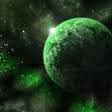 Space Pilot
Group: Users
 Italy
Italy
Messages: 120
Status: Offline
| Quote BlueDrache (  ) radiation shielding
the universe is made to be explored, but no one will ever visit it all
|
| |
| |
| sergejzivkovic | Date: Wednesday, 20.05.2015, 19:16 | Message # 108 |
|
Observer
Group: Users
 Pirate
Pirate
Messages: 18
Status: Offline
| I found planet that looks a lot like Earth...!
|
| |
| |
| IanTheGuy | Date: Sunday, 31.05.2015, 04:36 | Message # 109 |
 Space Pilot
Group: Users
 United States
United States
Messages: 96
Status: Offline
| Looking for earth like planets in 0.972 is alot harder. Like really hard.
And by that I mean the ones like yours.
Math is the "programming" language of the universe.
Edited by IanTheGuy - Sunday, 31.05.2015, 21:06 |
| |
| |
| Universe2598 | Date: Saturday, 14.11.2015, 19:17 | Message # 110 |
|
Observer
Group: Newbies
 Denmark
Denmark
Messages: 1
Status: Offline
| I have found lots of these planets in our galaxy in Space Engine
And wrote the coordinates to find the planets. Until now i have found around 52 planets or moons.
|
| |
| |
| Oatmeal_Spigeon | Date: Monday, 16.11.2015, 04:31 | Message # 111 |
 Space Tourist
Group: Users
 New Zealand
New Zealand
Messages: 39
Status: Offline
| Because Kantallo's Star is a G7V star; it's lifespan shouldn't be as much of a problem as it would be on, say, Kepler 452b.
"I am neither Oatmeal Spigeon Nor Oatmeal Spigeon Nor."
|
| |
| |
| Tac1017 | Date: Monday, 23.11.2015, 21:00 | Message # 112 |
 Explorer
Group: Users
 United States
United States
Messages: 167
Status: Offline
| Since I know this thread is more popular when it comes to Terra findings, I will post my images of my 0.974.7 find, Xerotas, here as well:








In case you're wondering, Xerotas is a pinkworld terra.
The Terra Hunter of the Milky Way!
(By the way, I was born in 2001, NOT 1972 XD)
Edited by Tac1017 - Tuesday, 24.11.2015, 21:00 |
| |
| |
| Watsisname | Date: Wednesday, 25.11.2015, 09:05 | Message # 113 |
 Galaxy Architect
Group: Global Moderators
 United States
United States
Messages: 2613
Status: Offline
| I like it. Xerotas is less Earth-like than Islutas, but I would still rate it very favorably in terms of habitability. There is no particular aspect of it that concerns me too much, and it has a lot of strong points across the board, particularly its mass, density, surface pressure, landmass coverage, and rotation period.
Of its potential weaknesses, I'd cite the 1/3 stronger surface gravity, and if we care of speculation of the atmospheric composition then I'm not sure what to make of its low molar mass (though it's higher than Islutas').

|
| |
| |
| Tac1017 | Date: Thursday, 26.11.2015, 02:34 | Message # 114 |
 Explorer
Group: Users
 United States
United States
Messages: 167
Status: Offline
| Hey, Gravity may be punishing, but maybe we can get over it... heh... besides, I have images of gas tubes so we can decide air composition  I assume mainly nitrogen and oxygen because of the low molar masses, but here they are! I assume mainly nitrogen and oxygen because of the low molar masses, but here they are!


definitely N2, and I hope there is oxygen, assuming that o2 is pale, maybe the thicker atmosphere makes up for it, and we could live there!
The Terra Hunter of the Milky Way!
(By the way, I was born in 2001, NOT 1972 XD)
Edited by Tac1017 - Thursday, 26.11.2015, 02:37 |
| |
| |
| Watsisname | Date: Thursday, 26.11.2015, 09:57 | Message # 115 |
 Galaxy Architect
Group: Global Moderators
 United States
United States
Messages: 2613
Status: Offline
| The atmosphere of Xerotas cannot be mostly N2 and O2, since those have molar masses of 28g/mol and 32g/mol respectively. Remember it all has to average out to 17.44g/mol. Actually... unfortunately... that kind of ruins the notion of this having an atmosphere breathable to humans.
The problem is that the only common atmospheric gases with molar masses less than 17.44g/mol are diatomic hydrogen (2g/mol), helium (4g/mol), and methane (16g/mol).
This means that the highest possible concentration of N2 this atmosphere could have is 59.3%, with the other 40.7% being hydrogen. (I'm using the equations I describe here to do these calculations.) Adding oxygen to the mix will only reduce the amount of nitrogen there can be, and increase the amount of hydrogen there would have to be. E.g. an atmosphere with 20% oxygen could only have a maximum of 36% N2, with the remaining 44% being H2.
That doesn't sound too bad. However, these are implausible atmospheres, since the planet is not massive enough to retain significant hydrogen or helium over billions of years. So the only gas that could realistically balance out the molar mass equation is methane. This dramatically reduces the possibilities. For instance, it means there cannot be more than 6.7% oxygen (with the rest being methane). "Heavy" gases like CO2, Ar, etc must also be in only small concentrations.
I think the most plausible atmosphere for this planet would be a "steam" atmosphere of mostly water vapor (18.02g/mol), balanced by methane, and maybe some nitrogen or other stuff in small amounts. Which is pretty interesting! My mind thinks of the Avatar world Pandora. 
[Edit:] Though, come to think of it, such an atmosphere would produce a much stronger greenhouse effect. And I doubt it could have that much water vapor without precipitating out. Oh well.
Disclaimer: This all assumes that we take the molar mass figure of the atmosphere seriously. We don't necessarily have to, since SE doesn't yet calculate compositions. When it does, this speculation will be unnecessary anyway.

|
| |
| |
| Tac1017 | Date: Thursday, 26.11.2015, 13:41 | Message # 116 |
 Explorer
Group: Users
 United States
United States
Messages: 167
Status: Offline
| maybe oxygen has a smaller presence on the planet? I hope that's the case; I want to to go strellix tanning on a Xeroatl beach!
On a more serious note, maybe we can rid the equation of nitrogen, and just leave us with oxygen (with possible nitrogen in amino acids to support our nutritional needs). What kind of atmosphere could we have then?
Either ways, I think as intelligent as we are (and signs of intelligence on xerotas, like precise cut rivers that go through what looked to be one landmass) we would be considered pests, and would need to stay in some sort of large indoor community, and communicate with the outside world through that. This is because we exhale a decent amount of CO2, and that could release huge amounts of the gas, which might be toxic to the pre-existing life)
If intelligent life existed there (if it were real), we would need to tell them to excuse our breathing habits. Maybe some bushery and trees around human colonies could stop such problems. On a ore bumorous note, we would just need to carry plants on our shoulder like pirates carry parrots.
The Terra Hunter of the Milky Way!
(By the way, I was born in 2001, NOT 1972 XD)
Edited by Tac1017 - Thursday, 26.11.2015, 14:37 |
| |
| |
| Tac1017 | Date: Friday, 27.11.2015, 23:22 | Message # 117 |
 Explorer
Group: Users
 United States
United States
Messages: 167
Status: Offline
| On a lighter note today, here is an image of a lunar eclipse that happened on this night on Xerotas:

The Terra Hunter of the Milky Way!
(By the way, I was born in 2001, NOT 1972 XD)
Edited by Tac1017 - Friday, 27.11.2015, 23:23 |
| |
| |
| Player1 | Date: Monday, 14.03.2016, 17:34 | Message # 118 |
 Astronaut
Group: Users
 Mexico
Mexico
Messages: 49
Status: Offline
| The rotation period looks weird, and what kind of moons does it have? Because the kind of moons is important, to slow down the rotation period and tides. It also must have a magnetic field (I can't see it in the pictures you took but I think it doesn't exist or its too weak) and an ozone layer. The axial angle is too tilted for an habitable planet, just imagine how the seasons would be like...
And there are other factors that could make that planet hostile for human life, for example, the rest of the planets in the solar system, like gas giants (they could protect the planet from asteroids or desestabilize its orbit if they're too close) , asteroids orbits, age, distance to the galaxy core (it's further than the Earth as I can see in the pics), distance to the nebulas and star clusters, distance from pulsars and dying stars, etc.
But I like the planet, the bets ESI I've ever seen in a extrasolar planet 
The temperate is nice, I like cold climes XD
(Sorry if I made mistakes in the post, I haven't wrote in english for too long...)
"We used to look up at the sky and wonder at our place in the stars, now we just look down and worry about our place in the dirt"
-Joseph Cooper, "Interstellar"
|
| |
| |
| Player1 | Date: Monday, 14.03.2016, 17:52 | Message # 119 |
 Astronaut
Group: Users
 Mexico
Mexico
Messages: 49
Status: Offline
| Nevermind, I found the moons on my own, I forgot I opened SE an hour ago XD The moons are good, but there's not a Barycenter like Earth-Moon system, so I think there's no rotation period decrease, but I found the magnetic field (it's something)
The closest star cluster is 402 parsecs away, that's good
And the other planets in the system are perfect, so there's left the atmospheric properties :P
"We used to look up at the sky and wonder at our place in the stars, now we just look down and worry about our place in the dirt"
-Joseph Cooper, "Interstellar"
|
| |
| |
| IanTheGuy | Date: Saturday, 14.05.2016, 17:01 | Message # 120 |
 Space Pilot
Group: Users
 United States
United States
Messages: 96
Status: Offline
| I can find planets with 0.900 ESI or higher with the star browser easily now.
I found these 5 babies
You should look at the stats of the 2nd one though.
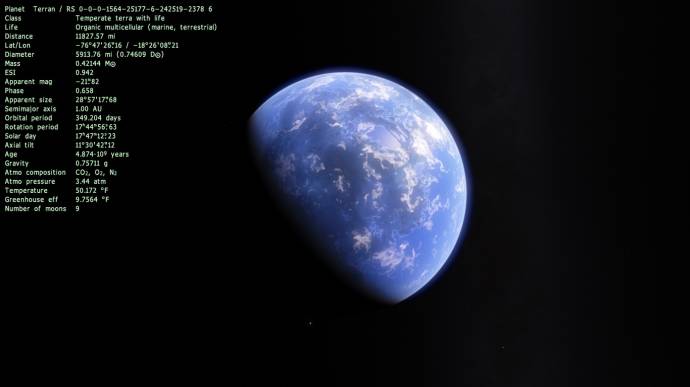
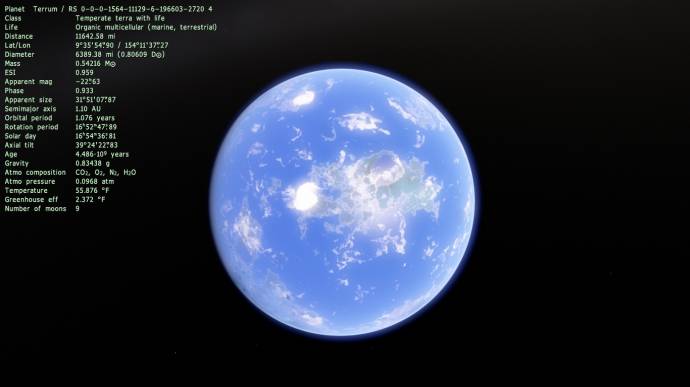
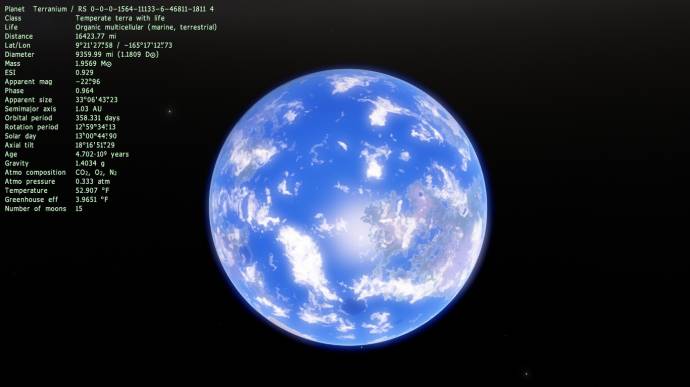
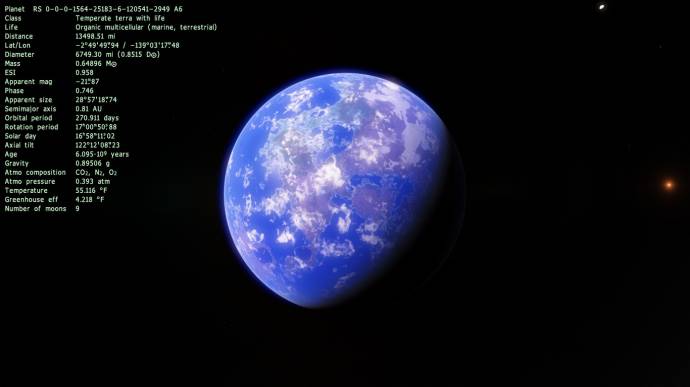
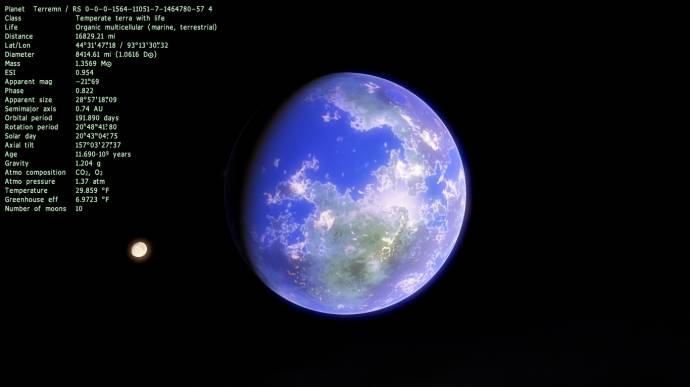
Math is the "programming" language of the universe.
Edited by IanTheGuy - Saturday, 14.05.2016, 21:10 |
| |
| |